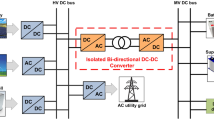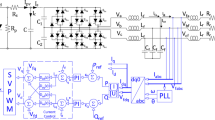Abstract
A high gain two-phase interleaved coupled inductor-based DC-DC converter step-up low input voltage sources like PV array and fuel cell in distribution generation system (DGS). The converter operates for a wide range of load changes when it is part of DGS. At light load, the converter operates in discontinuous conduction mode (DCM). A small-signal model (SSM) is required in both continuous conduction mode (CCM) and DCM to know the complete dynamic behavior of the converter. Steady-state and small-signal analysis of the two-phase interleaved coupled inductor boost converter (ICIBC) is quite complex when the converter operates in DCM. This paper presents the complete derivation of SSM of a two-phase ICIBC-based high step-up gain converter in DCM. The conditions of the converter operating in DCM are discussed. The small-signal model of two-phase ICIBC is derived using the state-space averaging method. The control-to-output voltage transfer function and steady-state voltage gain of the two-phase ICIBC are derived. When the converter operates in DCM, it eliminates the right half plane zero from the control-to-output voltage transfer function. Thus, it improves bandwidth and stability margin. Thus, single loop voltage control is sufficient to achieve regulated output voltage with faster response for all operating ranges of DCM. The laboratory prototype of two-phase ICIBC is implemented to step-up 24 V to 100 V at a power level of 300 W. The experimental results of two-phase ICIBC are obtained in DCM and CCM with step-change in load to validate the derived small-signal model.














Similar content being viewed by others
References
Swaminathan N, Cao Y (2020) An overview of high-conversion high-voltage dc-dc converters for electrified aviation power distribution system. IEEE Trans Transp Electrif 6(4):1740–1754. https://doi.org/10.1109/TTE.2020.3009152
Guan Y, Cecati C, Alonso JM, Zhang Z (2021) Review of high-frequency high-voltage-conversion-ratio dc–dc converters. IEEE J Emerg Select Top Industr Electron 2(4):374–389. https://doi.org/10.1109/JESTIE.2021.3051554
Forouzesh M, Siwakoti YP, Gorji SA, Blaabjerg F, Lehman B (2017) Step-up dc–dc converters: a comprehensive review of voltage-boosting techniques, topologies, and applications. IEEE Trans Power Electron 32(12):9143–9178. https://doi.org/10.1109/TPEL.2017.2652318
Sagar Bhaskar M, Ramachandaramurthy VK, Padmanaban S, Blaabjerg F, Ionel DM, Mitolo M, Almakhles D (2020) Survey of dc–dc non-isolated topologies for unidirectional power flow in fuel cell vehicles. IEEE Access 8:178130–178166. https://doi.org/10.1109/ACCESS.2020.3027041
Li W, He X (2011) Review of nonisolated high-step-up dc/dc converters in photovoltaic grid-connected applications. IEEE Trans Industr Electron 58(4):1239–1250. https://doi.org/10.1109/TIE.2010.2049715
Liu H, Hu H, Wu H, Xing Y, Batarseh I (2016) Overview of high-step-up coupled-inductor boost converters. IEEE J Emerg Select Top Power Electron 4(2):689–704. https://doi.org/10.1109/JESTPE.2016.2532930
Tofoli FL, de Castro Pereira D, de Paula WJ, Júnior DdSO (2015) Survey on non-isolated high-voltage step-up dc–dc topologies based on the boost converter. IET power Electron 8(10):2044–2057
Li F, Liu H (2017) A cascaded coupled inductor-reverse high step-up converter integrating three-winding coupled inductor and diode-capacitor technique. IEEE Trans Industr Inf 13(3):1121–1130. https://doi.org/10.1109/TII.2016.2637371
Azizkandi ME, Sedaghati F, Shayeghi H, Blaabjerg F (2020) A high voltage gain dc–dc converter based on three winding coupled inductor and voltage multiplier cell. IEEE Trans Power Electron 35(5):4558–4567. https://doi.org/10.1109/TPEL.2019.2944518
Premkumar M, Kumar C, Anbarasan A, Sowmya R (2020) A novel non-isolated high step-up dc–dc boost converter using single switch for renewable energy systems. Electr Eng 102(2):811–829
Mohebalizadeh G, Alipour H, Mohammadian L, Sabahi M (2021) A high step up multi-input dc/dc sepic-based converter with coupled inductor for renewable applications. Electric Power Comp Syst 1–15
Das PV, Karuppanan P, Singh AK, Babu BC (2020) Modelling, simulation and analysis of high step up dc–dc converter using coupled inductor and voltage multiplier cell using pscad. Int J Model Simul 40(1):29–36
Kurdkandi NV, Nouri T (2020) Analysis of an efficient interleaved ultra-large gain dc–dc converter for dc microgrid applications. IET Power Electron 13(10):2008–2018. https://doi.org/10.1049/iet-pel.2019.1138
Nouri T, Vosoughi Kurdkandi N, Shaneh M (2020) A novel zvs high-step-up converter with built-in transformer voltage multiplier cell. IEEE Trans Power Electron 35(12):12871–12886. https://doi.org/10.1109/TPEL.2020.2995662
Liu T, Lin M, Ai J (2020) High step-up interleaved dc–dc converter with asymmetric voltage multiplier cell and coupled inductor. IEEE J Emerg Select Top Power Electron 8(4):4209–4222. https://doi.org/10.1109/JESTPE.2019.2931634
Fani R, Erfani Majd N (2022) An interleaved ultra-high step up dc–dc converter with low voltage stress. Electr Eng 1–9
Middlebrook RD, Ćuk S (1977) A general unified approach to modelling switching-converter power stages. Int J Electron Theor Exp 42(6):521–550
Davoudi A, Jatskevich J, Rybel TD (2006) Numerical state-space average-value modeling of pwm dc–dc converters operating in dcm and ccm. IEEE Trans Power Electron 21(4):1003–1012. https://doi.org/10.1109/TPEL.2006.876848
Davoudi A, Jatskevich J, Chapman PL, Khaligh A (2007) Averaged-switch modeling of fourth-order pwm dc–dc converters considering conduction losses in discontinuous mode. IEEE Trans Power Electron 22(6):2410–2415. https://doi.org/10.1109/TPEL.2007.909270
Cuk S, Middlebrook R (1977) A general unified approach to modelling switching dc-to-dc converters in discontinuous conduction mode. In: 1977 IEEE Power Electronics Specialists Conference. IEEE, pp 36–57
Reatti A, Kazimierczuk MK (2003) Small-signal model of pwm converters for discontinuous conduction mode and its application for boost converter. IEEE Trans Circ Syst I: Fundam Theory Appl 50(1):65–73. https://doi.org/10.1109/TCSI.2002.805709
Erickson RW, Maksimovic D (2007) Fundamentals of power electronics. Springer, New York
Ayachit A, Kazimierczuk MK (2019) Averaged small-signal model of pwm dc–dc converters in ccm including switching power loss. IEEE Trans Circuits Syst II Express Briefs 66(2):262–266. https://doi.org/10.1109/TCSII.2018.2848623
Das HS, Li Z, Li S, Dong W (2021) Small signal modeling, control and experimentation of boost converter including parasitic elements. J Control Autom Electr Syst 32(4):956–967
Ang S, Oliva A, Griffiths G, Harrison R (2010) Power-switching converters. CRC Press, Boca Raton
Marcos-Pastor A, Vidal-Idiarte E, Cid-Pastor A, Martinez-Salamero L (2016) Interleaved digital power factor correction based on the sliding-mode approach. IEEE Trans Power Electron 31(6):4641–4653. https://doi.org/10.1109/TPEL.2015.2476698
Veerachary M, Senjyu T, Uezato K (2001) Modeling and analysis of interleaved dual boost converter. In: ISIE 2001. 2001 IEEE International Symposium on Industrial Electronics Proceedings (Cat. No.01TH8570), vol 2, pp 718–7222. https://doi.org/10.1109/ISIE.2001.931554
Luo Y-K, Su Y-P, Huang Y-P, Lee Y-H, Chen K-H, Hsu W-C (2012) Time-multiplexing current balance interleaved current-mode boost dc-dc converter for alleviating the effects of right-half-plane zero. IEEE Trans Power Electron 27(9):4098–4112. https://doi.org/10.1109/TPEL.2012.2188842
Azer P, Emadi A (2020) Generalized state space average model for multi-phase interleaved buck, boost and buck-boost dc–dc converters: Transient, steady-state and switching dynamics. IEEE Access 8:77735–77745. https://doi.org/10.1109/ACCESS.2020.2987277
Middlebrook RD (1975) A continuous model for the tapped-inductor boost converter. In: 1975 IEEE power electronics specialists conference, pp 63–79. https://doi.org/10.1109/PESC.1975.7085569
Muhammad M, Armstrong M, Elgendy MA (2016) Modelling and control of non-isolated high voltage gain boost converter employing coupled inductor and switched capacitor. In: 2016 international conference for students on applied engineering (ICSAE), pp 312–317. https://doi.org/10.1109/ICSAE.2016.7810209
Das M, Agarwal V (2017) Generalized small signal modeling of coupled-inductor-based high-gain high-efficiency dc–dc converters. IEEE Trans Ind Appl 53(3):2257–2270. https://doi.org/10.1109/TIA.2017.2657488
Vaghela MA, Mulla MA (2018) Modelling and control of high step-up gain multi-phase interleaved coupled inductor boost converter. In: 2018 IEEE international conference on power electronics, drives and energy systems (PEDES), pp 1–6. https://doi.org/10.1109/PEDES.2018.8707556
Javaheri Fard H, Sadeghzadeh SM (2022) Predictive and average current controllers for a high step-up interleaved dc–dc converter. J Control Autom Electr Syst 1–11
D’Amico MB, González SA (2019) Modelling and dynamical analysis of a dc–dc converter with coupled inductors. Electr Eng 101(1):67–80
Evans PD, Heffernan WJ (1996) Transformers and coupled inductors with optimum interleaving of windings. Google Patents. US Patent 5,543,773
Author information
Authors and Affiliations
Corresponding author
Additional information
Publisher's Note
Springer Nature remains neutral with regard to jurisdictional claims in published maps and institutional affiliations.
Rights and permissions
Springer Nature or its licensor (e.g. a society or other partner) holds exclusive rights to this article under a publishing agreement with the author(s) or other rightsholder(s); author self-archiving of the accepted manuscript version of this article is solely governed by the terms of such publishing agreement and applicable law.
About this article
Cite this article
Vaghela, M.A., Mulla, M.A. Small-signal model of two-phase interleaved coupled inductor-based high step-up gain converter in DCM. Electr Eng 105, 1565–1583 (2023). https://doi.org/10.1007/s00202-023-01739-0
Received:
Accepted:
Published:
Issue Date:
DOI: https://doi.org/10.1007/s00202-023-01739-0




